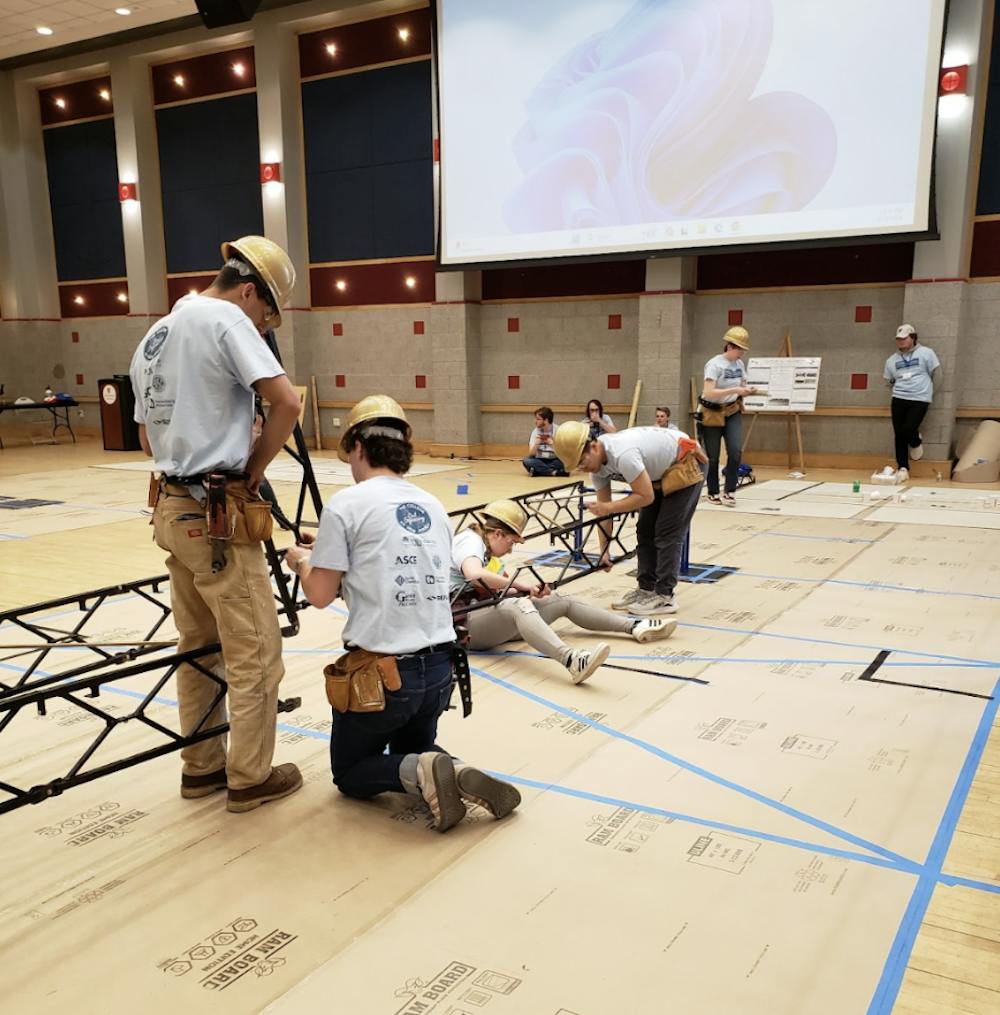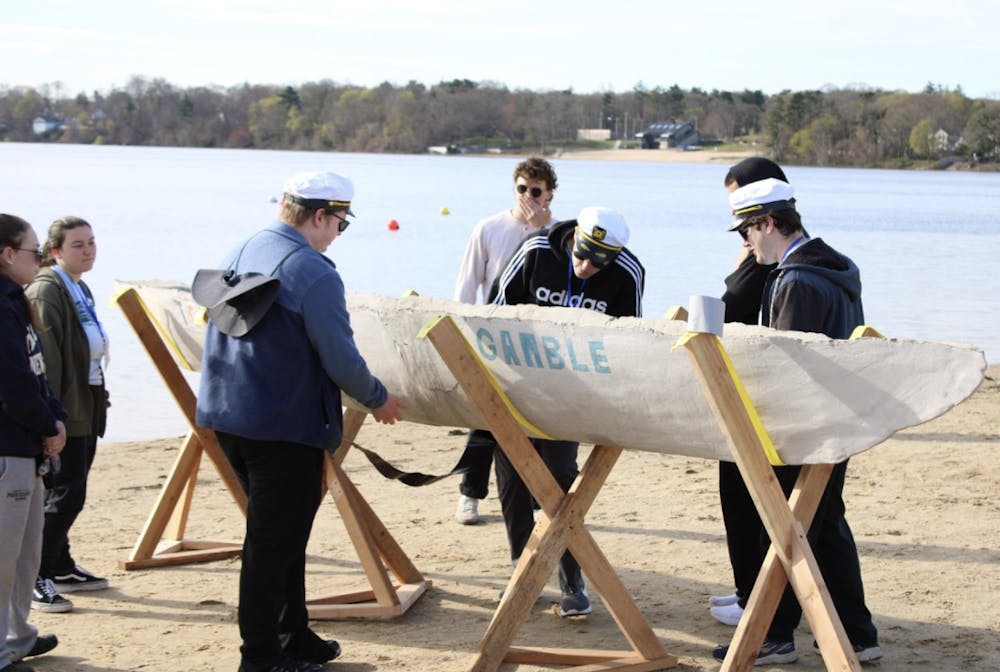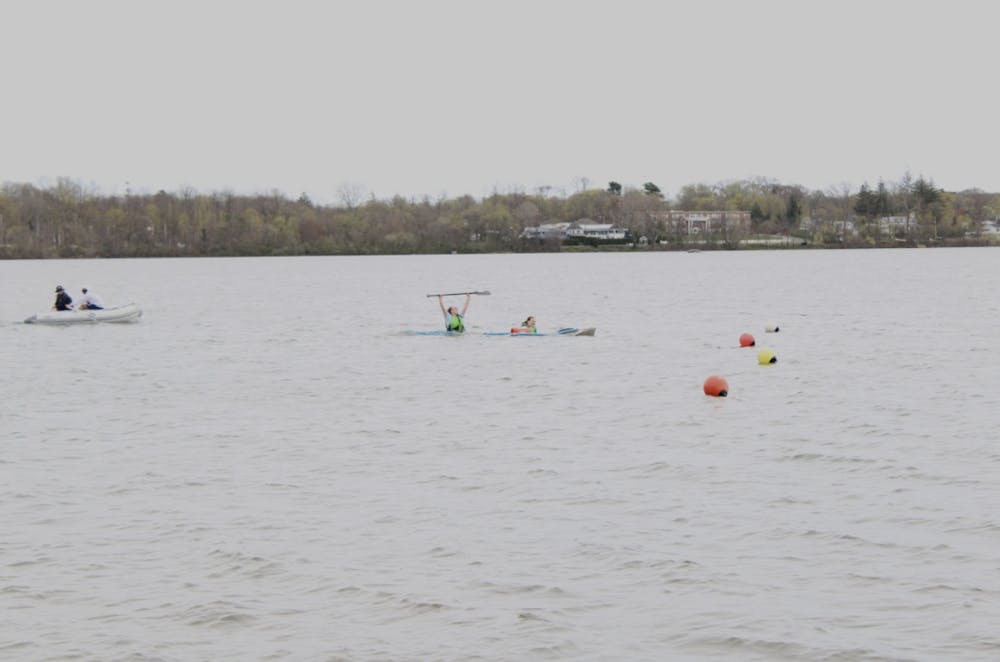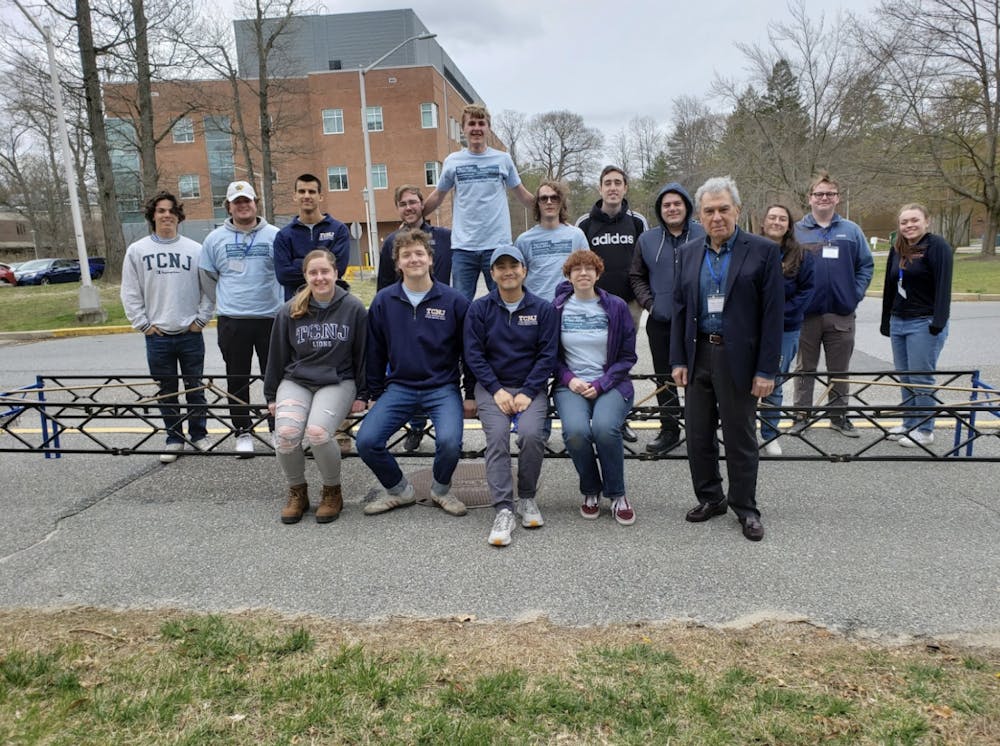By Mike Sherr
Former Editor-in-Chief
As the sun started to rise over the wind-chilled lake, Johnny Lombardelli, a senior civil engineering major, drove a U-Haul truck right up against the beach. Already standing on the gravelly beach were other engineering students from the College.
The students on the beach quickly opened up the back and filed in around a wooden box placed directly in the middle of the truck. The group hunched over and put their arms under the long item in the box.
“Ready?” asked John McElroy, another senior civil engineering major. “One, two, three!”
In a moment that needed the song from “2001: A Space Odyssey” playing in the background, the students carefully lifted up a gray concrete canoe and brought it to a set of stands waiting for it on the beach. The letters “TCNJ” were spray painted on the side along with the boat’s name: “Gamble.”
From April 12 to 14, students from the College’s civil engineering department competed against other schools at the American Society of Civil Engineers’ Metropolitan Student Symposium. The event, hosted by Stony Brook University, included paper presentations and competitions for steel bridge and concrete canoe teams.
Jill Stanton, a senior civil engineering major, presented her paper “Evaluating the ethical dilemmas of utilizing AI as a tool in engineering” in front of two ASCE judges. Stanton competed against 11 other colleges, giving a five minute presentation to two judges followed by a session of questions.
“I think I did my best during the competition,” Stanton told The Signal. “Public speaking is a weakness of mine, so I was definitely nervous at the beginning. I think I calmed down about halfway through and delivered a good presentation and answered the questions to the best of my ability.”
It is not clear how Stanton placed, however, since the judges at the symposium only announced the top three competitors.
Students on the steel bridge and canoe teams spent the whole academic year researching, designing and building their projects for their respective competition.
The steel bridge team, made up of senior civil engineering majors Matt Mentonis, Jack Davis, Josh Romero, Dora Krstic and Stanton, started researching and designing the parts of the bridge last semester.
“Me and other people in my group were really interested in structural engineering working with steel,” Davis told The Signal. “We learned a lot about it in classes and I kind of wanted to translate it to the real world.”
The group eventually moved on to assembling the parts to construct the 21-feet-long bridge with the help of Joe Zanetti, a professional services specialist who oversees the Manufacturing Lab at the College. Each part could only be 42 inches long and 6 inches tall.
The rest of the spring semester was spent practicing assembling the bridge, which was timed during the actual competition.
According to the 2024 rule book, each team is awarded points based on construction time, stiffness, structural efficiency, cost estimation, lightness, construction economy and aesthetics.
The steel bridge team went on to place third overall in the competition against eight other schools and first in the aesthetic category.

The steel bridge team during their timed construction competition (Photo courtesy of Vedrana Krstic).
Similar to the steel bridge team, the concrete canoe team spent the fall semester designing and testing concrete mixes. After multiple attempts of creating too heavy or too sandy concrete mixes, civil engineers Lombardelli, McElroy, Matthew Palermo, MacKenzie Bosland and Jamie Paddock decided on a lightweight mix to create a floating boat.
The group went on to mix and shape the concrete mix onto a mold, checking in periodically over winter break. Despite knowing that the boat would theoretically float, the concrete on the mold took until just weeks before the competition to fully cure, leaving no time for the team to test whether the canoe actually floated.

Members of the concrete canoe team look over Gamble before the judges inspect it for safety (Photo by Mike Sherr).
Even though the canoe successfully cured and was removed from the mold, the transportation from the College to Stony Brook damaged the boat. While on the beach, judges told the team that they could repair the damages with tape in order to compete, although they would take points off the group’s score.
After some quick repairs, Gamble passed the swamp test, which evaluated whether the boat would float or not. The canoe was filled with water and if it did not rise after being pushed under the water line, it would be disqualified.
“It was a big relief,” Lombardelli said. “Passing that test was the most important part.”
The team got to then race their canoe against five other schools in a race course on the lake. The College competed last in the first race, the women’s slalom.
About halfway through the race, Bosland and Paddock yelled to their teammates on the shore that water was flooding into the canoe. McElroy quickly ran into the lake with a bucket for the rowers to bail the water out, but to no avail as Gamble started to dramatically sink as it turned around to finish the course.

Senior civil engineering major Jamie Paddock lifting her oar in the air as the College’s concrete canoe sinks into the lake (Photo courtesy of Ryan Rosenthal).
As the canoe started to break up in the water, the ASCE judges told the group that Gamble was no longer safe to take part in the competition.
“We were disappointed,” Palermo told The Signal. “But we thought the canoe was still an overall success.”
Palermo noted that the group was the first canoe team from the College to compete in two years, showing significant improvement.
“I’ve been thinking about this project since about sophomore year,” Palermo said. “We learned a lot, and if we could do it again we would do some things differently.”
Despite not being able to race in any of the other competitions the College came in fifth, beating the Rutgers team by nine points.
While only the steel bridge team walked away with a top three placement, the students that attended the symposium left with real life experience through creative and unique projects. As the academic year comes to an end, current junior civil engineers will be looking towards the fall when they will restart these projects hoping to improve next year.







